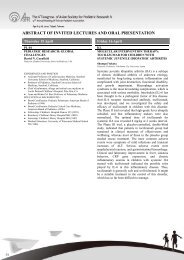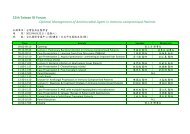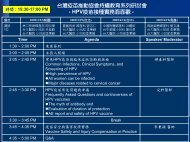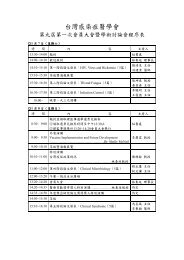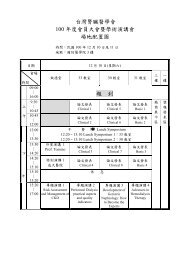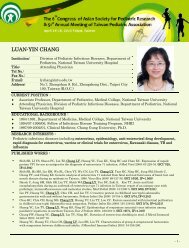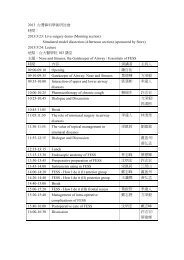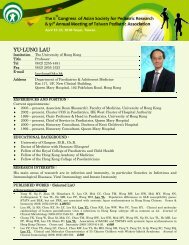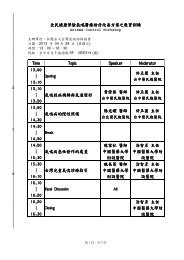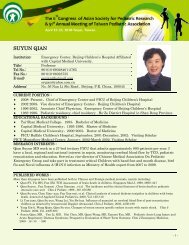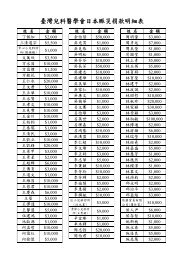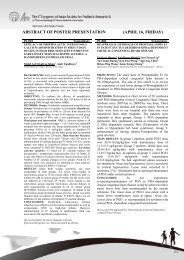ABSTRACT OF POSTER PRESENTATION (APRIL 17, SATURDAY)
ABSTRACT OF POSTER PRESENTATION (APRIL 17, SATURDAY)
ABSTRACT OF POSTER PRESENTATION (APRIL 17, SATURDAY)
You also want an ePaper? Increase the reach of your titles
YUMPU automatically turns print PDFs into web optimized ePapers that Google loves.
P2-011 Allergy/Immunology/Rheumatology P2-012 Allergy/Immunology/RheumatologyGENETIC DIAGNOSIS FOR PRIMARYIMMUNODEFICIENCIES: A SINGLE CENTEREXPERIENCE IN CHINATong-Xin Chen, 1,2 Xi Wang 2 , Rui-Ming Cao 2 ,Ying-Ying Jin 1 , Hui Zhang 2 , Juan-Juan Wang 2 ,Chun-Mei Yao 2 , Yu-Lung Lau 31 Department of Pediatrics, Xinhua Hospital, Shanghai Jiao TongUniversity School of Medicine, Shanghai, China; 2 Department ofImmunology/Oncology, Shanghai Institute for Pediatric Research, ShanghaiJiao Tong University School of Medicine, Shanghai, China; 3 Department ofPaediatrics and Adolescent Medicine, LKS Faculty of Medicine, TheUniversity of Hong Kong, HKSAR, ChinaMAPPING <strong>OF</strong> HUMAN IGE AND IGG1-4ANTIBODY-BINDING EPITOPES IN CYN D 1,THE MAJOR ALLERGEN <strong>OF</strong> BERMUDA GRASSPOLLENHan-Chih Yuan 1,2 , Ho-Jen Peng 1,2 , Keh-Gong Wu 1Department of Pediatrics 1 , Medical Research and Education 2 , Taipei VeteransGeneral Hospital, TaiwanOBJECTIVE: Our study aims to review the clinicalfeatures and genetic diagnoses of 218 patients withprimary immunodeficiencies refered to our center from2004-2009.METHODS: The genomic DNA of patients and theirfamily members were detected by PCR-directedsequencing of corresponding pathogenic genes of thesePID patients based on their clinical manifestations andimmunological evaluations.MAIN RESULTS: Our cohort included 201 males and <strong>17</strong>females from 20 provinces in China. Most of themcharacterized by recurrent respiratory infections, diarrheaand skin infections, 29 of them were found withautoimmnune disease(JRA 13, ALPS 2, SLE 1, colitis 9,neutropenia 6) and 4 with tumor. Fourteen genessequencing had been done including BTK, CD40L, AID,TACI, μheavy chain, IL-2RG, PNP, WASP, IL-12RB1,SH2D1A, Fas, FasL, CYBB, CD18 and 52 types mutationsdefined with 34 family members confirmed to be carriers.Forty-eight males were found to have BTK mutationsamong 54 patients suspected to be XLA including 14missense, 3 multiple, 5 deletion and 6 splice-junctionmutations. Four males had CD40L mutation including 3deletion and 1 insertion. Four males had IL-2RG mutationincluding 1 missense, 1 multiple and 2 splice-junctionmutations. Eight males had WASP mutations including 5deletion, 2 missense, 1 duplication and 1 splice-junctionmutations. Two males had SH2D1A mutations amongwhich 1 with nonsense and 1 with multiple mutations.IL-12RB1 mutation (compound heterozygous missensemutation) was found in a patient with BCG disease. CYBBgene mutation was found in a patient with disseminatedBCG but his mother was normal and spontaneous mutationmay be the cause. CD18 mutation (missense) was found ina male and his father and mother defined to be carriers.CONCLUSIONS: Most patients in out cohort were malewith higher mortality for those as delayed diagnosis andsevere infections. Genetic diagnosis can provide earlydiagnosis and therapy for children suffering from PID.Finding carrier are necessary for avoiding birth of PIDpatients.[Keywords] genetic diagnosis; PIDOBJECTIVES: Bermuda grass pollen (BGP) is animportant aeroallergen worldwide which induces allergicrhinitis and asthma. The positive rate of skin tests to thecrude BGP extract was about 27% in asthmatic childrenin Taiwan. Cyn d 1 is the major allergen of BGP. Its IgEand IgG1-4 antibody-binding epitopes werecharacterized for the first time in the present study.METHODS: Synthetic peptides (10-mers; 5overlapping residues) spanning the entire length of Cynd 1 were used to map specific IgE and IgG1-4antibody-binding epitopes in the sera of BGP allergicchildren. For further mapping of exact epitopes, 9overlapping peptides were further employed. Eachoverlapping peptide was stepwise different from theprevious peptide by one residue, upstream ordownstream. The essential amino acids for specific IgEand IgG1-4 antibody binding within each epitopes wereexamined by single amino acid substitution with alanine.Epitopes of BGP isoforms were also included tocompare their differences among IgG 1-4 and IgEantibody binding.MAIN RESULTS: Based on the results of peptidebinding in the sera of 22 patients, three IgE bindingepitopes (amino acids 101-110, 161-<strong>17</strong>0 and <strong>17</strong>1-180)and three IgG epitopes (amino acids 71-80, 146-155 and191-200) were selected for further epitope mapping ofCyn d 1. Three IgE-binding epitopes were positioned atamino acids 101-110, 159-167 and <strong>17</strong>2-181, while threeIgG-binding epitopes were positioned at amino acids70-79, 144-153 and 192-200. The epitopes for IgG1,IgG2, IgG3, and IgG4 were identical. Critical aminoacids for IgE- and IgG-binding epitopes were alsocharacterized. In addition, both epitopes for twoisoforms of Cyn d 1 (1 for IgG and 1 for IgE) had strongantibody-binding capacity.CONCLUSIONS: This is the first study to identify theepitopes of IgE and IgG subclasses in Cyn d 1. It will behelpful for future development of safer immunotherapyand better diagnostic kits.[Keywords]Cyn d 1, antibody-binding epitope, synthetic peptide, dotimmunoblotting260



